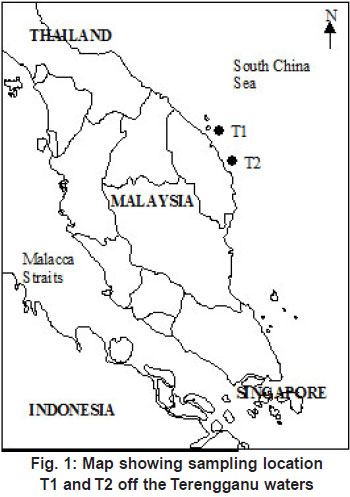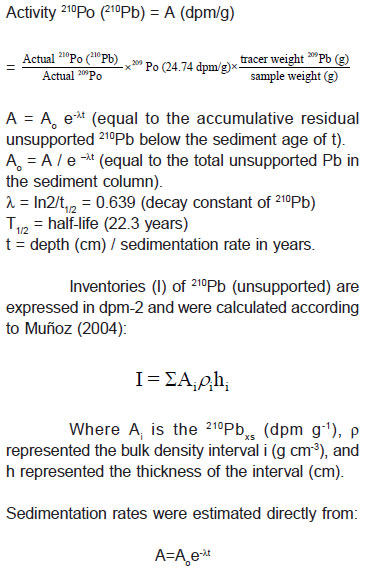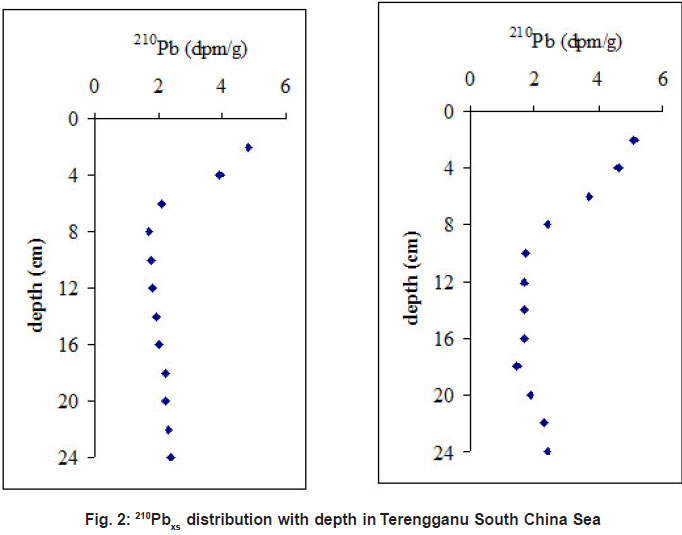The determination of 210Pb in the sediments: Sedimentation rates from the Terengganu coastal waters, Malaysia
B.Y. Kamaruzzaman1 * and M.C. Ong2
DOI: http://dx.doi.org/10.12944/CWE.5.1.02
Detail 210Pb analysis of two core samples collected with a gravity corer from the coastal water of Terengganu South China Sea has provided a chronology of the sediments identifying the subtle yet distinct variations in recent sedimentation. This investigation of recent sedimentation with the use of 210Pb analyses is a part of an overall study to examine and quantify past and present patterns and rates of sedimentation, revealing how deposition environments and their morphological structure transform. To assess the recent to sub-recent depositional processes in the Terengganu coastal water, a detailed sediment analysis was conducted. The activities of natural radionuclide 210Pb along with the 208Po tracer were measured by Alpha Spectrometry to estimate sedimentation rate and mass accumulation rate. The highest accumulation rates were recorded near the Terengganu river estuary, seem to be controlled by several addition factors that modulate the settling particles, such as onshore precipitation and river runoff and the lower rates near the island.
Copy the following to cite this article:
Kamaruzzaman B. Y, Ong M. C. The determination of 210Pb in the sediments: Sedimentation rates from the Terengganu coastal waters, Malaysia. Curr World Environ 2010;5(1):09-14 DOI:http://dx.doi.org/10.12944/CWE.5.1.02
Copy the following to cite this URL:
TKamaruzzaman B. Y, Ong M. C. The determination of 210Pb in the sediments: Sedimentation rates from the Terengganu coastal waters, Malaysia. Curr World Environ 2010;5(1):09-14. Available from: http://www.cwejournal.org/?p=1088
Download article (pdf) Citation Manager Publish History
Select type of program for download
| Endnote EndNote format (Mac & Win) | |
| Reference Manager Ris format (Win only) | |
| Procite Ris format (Win only) | |
| Medlars Format | |
| RefWorks Format RefWorks format (Mac & Win) | |
| BibTex Format BibTex format (Mac & Win) |
Article Publishing History
| Received: | 2009-10-11 |
|---|---|
| Accepted: | 2010-04-17 |
Introduction
Continental margins from a link between the ocean and land is an important areas for understanding the biogeochemical cycles of heavy metals, carbon and other materials (Anderson et al., 1994; Yamada and Aono, 2003; Masuzawa et al., 2003). In addition to land-derived materials, a large quantity of particles are produced in situ by high primary production and transported away from the land to the sea through river and estuary (Kato et al., 2003). Mechanisms that promote sedimentation lead to the sequestration of large amounts of organic matter as well as mad-made heavy metals and other contaminants.
Sedimentation rate and mass accumulation rate are useful to understand sediment-transport processes and the flux of themajor constituents of the sediments, as lithogenic and organic components, both important for geochemical studies (Alperin et al., 2002; Borole, 2002; Gorgas and Wilkens, 2002). Aelian transport of lithogenic particles could constitute an important input to the deep sea sediments. Size, shape and composition of settling particles are important factors that determine transport and preservation in the sediments. Moreover, morphologic characteristic of the seafloor, such as the presence of canyons, slope terraces and govern sediment accumulation patterns (Masqué et al., 2002; Muñoz et al., 2004).
Naturally occurring radioisotope 210Pb has been widely utilized to determine sedimentation rates in coastal continental margin sediments and despite some limitations of the methodology, it has demonstrated to be a useful tool to estimate recent sedimentation rates (White et al., 2002; Moon et al., 2003; Shotyk et al., 2005; Crusius et al., 2004; Huh and Chen, 1999; Oguri et al., 2003; Masqueet al., 2003). 210 Pb is a natural product of the 238U decay series with a half-life of 22.3 years. Basically, 210Pb content in seawater is supplied from the insitu decay of 226Ra in seawater and 222 Rn in the atmospheric and subsequent rainout to the ocean surface. 210Pb is efficiently scavenged by suspended fine particles and thus actively removed from seawater on timescales comparable to its half-life (Henderson and Maier-Reimer, 2002); it is deposited on the seafloor, producing an excess with respect to 226 Ra decay within the sediments. This allows the estimation of sedimentation rate where productivity and adjective processes are considered to be important aspects in the distribution and removal of 210 Pb in the water column (Nozaki et al., 1997; Thomson and Turekian, 1976).
South China Sea Terengganu waters are located in eastern peninsular Malaysia. The surrounding community of Terengganu waters is mainly depends on the sea as the source of income particularly the fisherman. In recently year, the coastal area of Terengganu was rapidly developed in order to maximize the employment of natural resources in the marine environment. Importance of this coastal area as a fishing area yet is exposed to large different of sediment transportation pattern as the great development is carrying out along the Terengganu river, Marang river, Merchang river and Paka river.
Material and Method
Collection and Sampling of Sediments
Core sample was collected in Terengganu waters in August 2004 using gravity corer (Fig. 1). Samples was then stored in the PVC pipe and keep in freezer in order to minimize contamination. In the laboratory, sediment cores were sliced into 2cm intervals and were dried at 60oC to a constant weight and homogenized to analyses the 210Pb activities, determined mainly by alpha spectrometry of its daughter, 210Po.
 |
figure 1: Map showing sampling location T1 and T2 off the Terengganu waters click here to view figure |
Chemical Analysis
For the chemical analysis, 2g of dried sample was placed in a beaker and digested with HNO3 with a spike of 0.275ml of 209Po. The solution was heat on the hot plate in the temperature of less that 60°C (209Po will be lost in temperature above 60°C) for 24 hours. Time and date are necessarily to be recorded. Each additive of acid required 24 hours for digesting such as HClO4, HCl, and 6M of HCl. After that, sample solution was centrifuged and plated onto the silver foil with the presence of ascorbic acid for 24 hours.
After the deposition process, deposited silver plate will be dried in room temperature before detect by Alpha Spectrometry, Canberra model. The activities 209Po and 210Po will be appeared in a peak form which will be assisting in the calculation of 210Pb (dpm/g). The duration of counting will takes for at least 3 days
Data Analysis
The activity of 210Pb is obtained by the formula below:

Neither estimation considers the mixing effect. Since other radionuclides are not available for this study, we worked with the 210 Pb activities below the mixing layer (Lewis et al., 2002; Oguri et al., 2003). Thus our estimates on sedimentation rate assume that mixing is negligible below the mixed layer, where sedimentation is the dominant process. On the other hand, the use of a constant value to estimate the unsupported 210 Pb (in excess) where no 226Ra data are available does not greatly affect sedimentation rate estimations; 226 Ra is usually constant with depth and 226Ra value agree well with 210 Pb values at the base of the sediment cores (Radakovitch and Heussner, 1999; Oguri et al., 2003).
Results and Discussion
Figure 2 shows the activities of 210Pbxs was decreasing exponentially with depth from 0 – 8cm depth. The activities were later increased from 8cm onwards to 18cm and finally reaching constant values at ~18cm to 26cm. A higher value of 210 Pb activity on the surface might be caused by the fresh deposition particle which basically derived from the atmosphere and land. Besides that, this might be also resulting from 210 Pb initial activity of settling particles and additional scavenging in the water column, or from older sediment issued from resuspension (Miralles et al. 2005). It is clear that 210 Pb increases monotonically with depth, suggesting of the particulate scavenging (Chung et al. 2004). Thus, the scavenging of 210 Pb from the sediment and water column might be a reason to the increases of 210 Pb value from 8 cm to 18 cm depth.
 |
Figure 2: 210Pbxs distribution with depth in Terengganu South China Sea |
The established method of 210 Pb indicates the sedimentation rate of Terengganu South China Sea was 0.30 cm year-.1 Reading was obtained by selecting the ‘best-curve’ from the establishment 210Pb (dpm g-1) distribution with depth. Study discovered the mixing layer and bioturbation in the top core layer was insignificant which displayed the R2 ≥ 0.9 (0 to 8 cm). The influences of sedimentation rate in South China Sea is mainly depends on the seasonal current movement particularly northeast monsoon and southeast monsoon. Sediment accumulation rate might be more significant during the northeast monsoon which leads to the increases of river input in the coastal area. Besides that, sediment size and portion was also interfered the sedimentation rates in most area of South China Sea particularly Terengganu water.
In general, sedimentation rate along the Terengganu coastal water show no significant different. Since mass accumulation rate is related to the density of the sediments, changes in particle composition could somewhat complicate data interpretation. Strong precipitation and river discharges along the Terengganu coastal transport terrigenous matter and sediment to the ocean. This constitutes an additional source of particle, increasing sedimentation rate with a predominance of siliciclastic material over organic particles. It is evident that the different topographic settings of the study area also contribute to the differences in sedimentation rate. Low sedimentation are comparable to low values reported for northern South China Sea, 0.23 cm/year (Chung et al., 2004), Peru shelf, 0.07-0.32 cm/year (Koide and Goldberg, 1982: Kim and Burnett, 1988), Bay of Biscay, 0.2-0.5 cm/year (Lesueur et al., 2001) and East China Sea, 0.3-1.0 cm/year (Huh and Chen, 1999), where erosive processes plan an important role in the distribution of the sediment (Froelich et al., 1988).
Conclusion
210Pb established method deployed in the Terengganu South China Sea water indicates the distribution of 210 Pb activities was varies according to depth. Core sample did not indicate a significant of mixing layer as well as bioturbation activities. The sedimentation rate in Terengganu South China Sea was mainly influenced by the ambient forces such as current motion (lateral transport) and river input especially during the northeast monsoon season. Top core layer experiencing the freshly deposition of 210 Pb sources from terrestrial and atmosphere. Meanwhile the increases of 210 Pb activity in the deep core were suggested due to the particulate scavenging from the water column and the deeper sediment pore.
- Alperin M. J., Suayah I., Benninger L. K., Martens C. Modern organic carbon buria fluxes, recent sedimentation rates, and particle mixing rates from the upper continental slope near Cape Hatteras, North Carolina (USA). Deep Sea Research Part II: Topical Studies in Oceanography 49(20),4645-4665. doi:10.1016/S0967-0645 (02)00133-9 (2002).
- Anderson R. F., Rowe G. T., Kemp P. F.,Trumbores S., Biscaye P. E. Carbon budget for the mid slope depocenter of the Middle Atlantic Bight. Deep Sea Research Part II: Topical Studies in Oceanography 41(2-3): 669-703 (1994). doi:10.1016/0967-0645(94)90040-X.
- Borole D. V. Analysis of 210Pb in sediment trap samples and sediments from the northern Arabian Sea: evidence for boundary scavenging. Deep Sea Research Part I:Oceanographic Research Papers 49(6),1055-1069. doi:10.1016/S0967-0637(02)00013-4 (2002).
- Chung Y., Chang H.C., Hung G. W. Particulate flux and 210Pb determined on the sediment trap and core samples from the northern South China Sea. Continental Shelf Research 24(6): 673-691 (2004).doi:10.1016/j.csr.2004.01.003.
- Crusius J., Bothner M. H., Sommerfield C. K. Bioturbation depths, rates and processes in Massachusetts Bay sediments inferred from modeling of 210Pb and 239 + 240Pu profiles. Estuarine, Coastal and Shelf Science 61(4): 643-655 (2004). doi:10.1016/j.ecss.2004.07.005.
- Froelich P. N., Arthur M. A., Burnett W. C.,Deakin M., Hensley V., Jahnke R., Kaul L.,Kim K. H., Roe K., Soutar A., Vathakanon C. Early diagenesis of organic matter in Peru continental margin sediments: Phosphorite precipitation. Marine Geology 80(3-4): 309-343 (1988). doi:10.1016/0025-3227(88)90095-3.
- Gorgas T. J., Wilkens R. H. Sedimentation rates off SW Africa since the late Miocene deciphered from spectral analyses of borehole and GRA bulk density profiles: ODP Sites 1081–1084. Marine Geology 180(1-4):29-47 (2002). doi:10.1016/S0025-3227(01)00204-3.
- Henderson G. M., Maier-Reimer E. Advection and removal of 210Pb and stable Pb isotopes in the oceans: a general circulation model study. Geochimica et Cosmochimica Acta 66(2): 257-272 (2002).doi:10.1016/S0016-7037(01)00779-7
- Huh C. A., Chen H. Y. History of Lead Pollution Recorded in East China Sea Sediments. Marine Pollution Bulletin 38(7):545-549 (1999). doi:10.1016/S0025-326X(98) 00111-8.
- Kato Y., Kitazato H., Shimanaga M., Nakatsuka T, Shirayama Y., MasuzawaT. 210Pb and 137Cs in sediments from Sagami Bay, Japan: sedimentation rates andinventories. Progress in Oceanography57(1): 77-95 (2003). doi:10.1016/S0079-6611(03)00052-
- Kim K.H. and Burnett W.C., Accumulation and biological mixing of Peru marginsediments. Marine Geology 80(3-4): 181-194(1988). doi:10.1016/0025-3227(88) 900898.
- Koide M., Goldberg E. D. Transuranic nuclides in two coastal marine sediments off Peru. Earth and Planetary Science Letters.57(2): 263-277 (1982). doi:10.1016/0012-821X(82)90149-2
- Lesueur P., Jouanneau J. M., Boust D., Tastet J. P., Weber O. Sedimentation rates and fluxes in the continental shelf mud fields in the Bay of Biscay (France). Continental Shelf Research 21(13-14): 1383-1401 (2001).doi:10.1016/S0278-4343(01)00004-8
- Lewis R. C., Coale K. H., Edwards B. D., Marot M., Douglas J. N., Burton E. J. Accumulation rate and mixing of shelf sediments in the Monterey Bay National Marine Sanctuary. Marine Geology 181(1-3): 157-169 (2002). doi:10.1016/S0025-3227(01)00265-1.
- Masqué P., Enrique I., Sanchez-Cabeza J. A.,Palanques A., Bruach J. M., Puig P., Guillén J. Sediment accumulation rates and carbon fluxes to bottom sediments at the Western Bransfield Strait (Antarctica). Deep Sea Research Part II: Topical Studies in Oceanography 49(4-5): 921-933(2002).doi:10.1016/S0967-0645(01)00131-X.
- Masqué P., Fabres J., Canals M., Sanchez-Cabeza J. A., Sanchez-Vidal A., Cacho I.,Calafat A. M., Bruach J. M. Accumulation rates of major constituents of hemipelagicsediments in the deep Alboran Sea: acentennial perspective of sedimentarydynamics. Marine Geology 193(3-4): 207-233 (2003). doi:10.1016/S0025-3227(02)00593-5.
- Masuzawa T. Li T., Duan Y., Yamamoto M.,Hibi Y., Nakatsuka T., Kitazato H. and KatoY., Temporal variation in mass fluxes and the major components of sinking particles in Sagami Bay, off Japan. Progress in Oceanography. 57(1): 59-75 (2003).doi:10.1016/S0079-6611(03)00051-X.
- Miralles J., Radakovitch O., Aloisi J. C. 210Pb sedimentation rates from the Northwestern Mediterranean margin. Marine Geology 216(3): 155-167 (2005).doi:10.1016/ j.margeo.2005.02.020.
- Moon D. S., Hong G. H., Kim Y. I., Baskaran M., Chung C. S., Kim S. H., Lee H. J., Lee S. H., Povinec P. P. Accumulation of anthropogenic and natural radionuclides in bottom sediments of the Northwest Pacific Ocean. Deep Sea Research Part II: Topical Studies in Oceanography 50(17-21): 2649-2673 (2003). doi:10.1016/S0967-0645(03) 00140-1.
- Muñoz P., Lange C. B., Gutiérrez D., Hebbeln D., Salamanca M. A., Dezileau L., Reyss J. L., Benninger L. K. Recent sedimentation and mass accumulation rates based on 210Pb along the Peru–Chile continental margin.Deep Sea Research Part II: Topical Studies in Oceanography 51(20-21): 2523-2541(2004). doi:10.1016/j.dsr2.2004.08.015.
- Nozaki Y., Dobashi F., kato Y., Yamamoto Y. Distribution of Ra isotopes and the 210Pb and 210Po balance in surface seawaters of the mid Northern Hemisphere. Deep Sea Research Part I: Oceanographic Research Papers 45(8): 1263-1284 (1998).doi:10.1016/ S0967-0637(98)00016-8.
- Oguri K., Matsumoto E., Yamada M., Saito Y., Iseki K., Sediment accumulation rates and budgets of depositing particles of the East China Sea. Deep Sea Research Part II: Topical Studies in Oceanography 50(2):513-528 (2003). doi:10.1016/S0967 0645(02)00465-4.
- Radakovitch O., Heussner S. Fluxes and budget of 210Pb on the continental margin of the Bay of Biscay (northeastern Atlantic).Deep Sea Research Part II: Topical Studies in Oceanography 46(10): 2175-2203 (1999).doi:10.1016/S0967-0645(99)00059-4.
- Shotyk W., Goodsite M. E., Roos-Barraclough F., Givelet N., Le Roux G., Weiss D.,Cheburkin A. K., Knudsen K., Heinemeier J., van Der Knaap W. O., Norton S. A. Lohse C., Accumulation rates and predominant atmospheric sources of natural and anthropogenic Hg and Pb on the Faroe Islands. Geochimica et Cosmochimica Acta 69(1): 1-17 (2005). doi:10.1016/j.gca.2004.06.011doi: 10.1016/j.gca.2004. 06.011.
- Thomson J., Turekian K. K. 210Po and 210Pb distributions in ocean water profiles from the Eastern South Pacific. Earth and Planetary Science Letters 32(2): 297-303 (1976).doi:10.1016/0012-821X(76)90069-8.
- White W. A., Morton R. A., Holmes C. W. A comparison of factors controlling sedimentation rates and wetland loss in fluvial–deltaic systems, Texas Gulf coast. Geomorphology 44(1-2): 47-66 (2002).doi:10.1016/S0169-555X(01)00140-4.
- Yamada M.,Aono T.,210Pb and 234Th in settling particles collected by time-series sediment traps in the Okinawa Trough. Deep Sea Research Part II: Topical Studies in Oceanography 50(2): 487-501 (2003).doi:10.1016/S0967-0645(02)004666.







